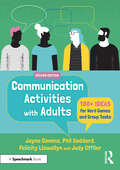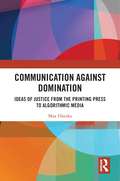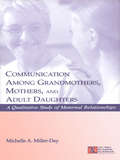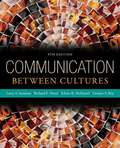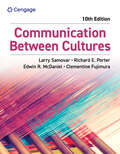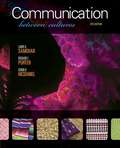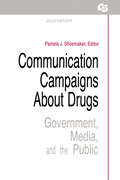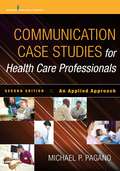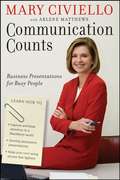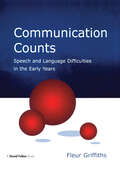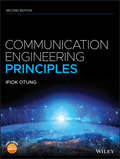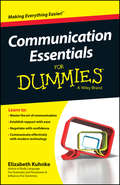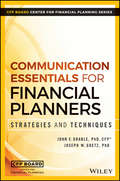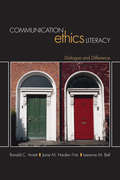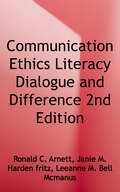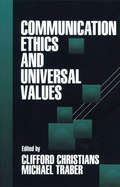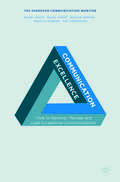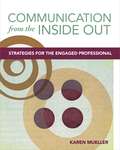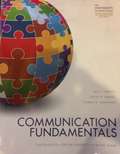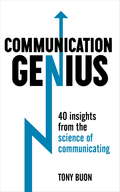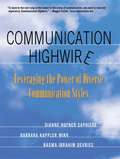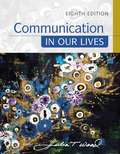- Table View
- List View
Communication Activities with Adults: 100+ Ideas for Word Games and Group Tasks
by Jayne Comins Felicity Llewellyn Judy Offiler Phil GoddardProviding over 100 ideas for word games and group activities, this book is the perfect timesaver for the busy practitioner. The instructions for each activity have been kept to a minimum, so you can easily adapt it to your clients’ communication, cognitive, and reading skills. This is a new edition of a book that has been in print for over forty years. It includes brand-new activities and a full update of existing ones to make them relevant to the 2020s. Tasks are divided into three sections: Short Answers, suitable for limited communication or quick-fire tests; more demanding Longer Answers that require a series of words or sentences; and Longest Answers, for more open-ended tasks and group work. The handbook will allow anyone working with groups and individuals with communication difficulties to plan sessions quickly and easily. It has long been an essential part of the toolkit for every speech and language therapist, care professional, and activity provider. Most importantly, it is intended to get people talking, and to make therapy fun for you and your clients.
Communication Against Domination: Ideas of Justice from the Printing Press to Algorithmic Media
by Max HänskaThis book tackles the philosophical challenge of bridging the gap between empirical research into communication and information technology, and normative questions of justice and how we ought to communicate with each other. It brings the question of what justice demands of communication to the center of social science research. Max Hänska undertakes expansive philosophical analysis to locate the proper place of normativity in social science research, a looming subject in light of the sweeping roles of information technologies in our social world today. The book’s first section examines metatheoretical issues to provide a framework for normative analysis, while the second applies this framework to three technological epochs: broadcast communication, the Internet and networked communications, and the increasing integration of artificial intelligence and machine learning technologies into our communication systems. Hänska goes beyond the prevailing frameworks in the field by exploring how we answer normative questions and how our answer can change depending on our social context and the affordances of prevailing communications technologies. This book provides an essential guide for scholars as well as graduate and advanced undergraduate students of research and theory in communication, philosophy, political science, and the social sciences.
Communication Among Grandmothers, Mothers, and Adult Daughters: A Qualitative Study of Maternal Relationships (LEA's Series on Personal Relationships)
by Michelle A. Miller-DayThis volume examines communication processes within the grandmother-mother-daughter relationship, emphasizing an intergenerational perspective. Using observations of and extensive interviews with six sets of middle-income, Caucasian female family members, this book offers a heuristic account of intergenerational mother-daughter relational communication.Author Michelle Miller-Day integrates and juxtaposes alternative experiences of social interaction, situating readers in the world of grandmothers, mothers, adult daughters, and granddaughters as they experience, describe, and analyze their family communication. Miller-Day incorporates aged mothers and younger mid-life mothers and their adult daughters into the research to illustrate how this type of maternal relationship is experienced at different points in a woman's life. With the inclusion of three generations of women, Miller-Day offers multigenerational perspectives on family, and examines them for patterns of maternal interaction, providing symbolic links across generational boundaries.Communication Among Grandmothers, Mothers, and Adult Daughters enables readers to understand more completely the richly textured nature of maternal relationships. It will be an invaluable resource for scholars and researchers in the areas of communication and relationships, including family communication, intergenerational communication, women's studies, family studies, interpersonal communication, and relationships, as well as social workers, psychologists, and counselors, who strive to understand family communication processes and their dynamics across generational lines.
Communication Between Cultures
by Richard E. Porter Larry A. Samovar Edwin R. McDaniel Carolyn Sexton RoyEmphasizing the roles that family, religion, and history play in intercultural communication, COMMUNICATION BETWEEN CULTURES, 9E helps you increase your understanding and appreciation of different cultures while developing practical skills for improving your communication with people from other cultures. Bringing chapter concepts to life, the text is packed with the latest research and compelling examples that help you take a look at your own assumptions, perceptions, and cultural biases so you can see the subtle and profound ways culture affects communication. The ninth edition also includes insightful discussions of the impact of globalization, a new chapter on intercultural communication competence, and extensive coverage of new technology.
Communication Between Cultures
by Richard E. Porter Larry A. Samovar Edwin R. McDaniel Clementine K. FujimuraWith its incorporation and representation of diverse perspectives, Samovar/Porter/McDaniel’s COMMUNICATION BETWEEN CULTURES, 10th Edition, helps students increase their understanding of the importance of cultural understanding for successful intercultural interactions. Packed with the latest research and compelling examples, this edition helps students look at their own assumptions, perceptions and cultural biases so they can see the subtle and profound ways culture affects communication. The 10th Edition addresses the importance of intercultural communication in the context of current global and technological and is accessible to all students, inclusive in its writing and personalization of activities.
Communication Between Cultures (Eighth Edition)
by Richard E. Porter Larry A. Samovar Edwin R. Mcdaniel Carolyn S. RoyThis intercultural communication text gives readers an understanding and appreciation of different cultures and helps them develop practical skills for improving their communication with people from other cultures.
Communication Campaigns About Drugs: Government, Media, and the Public (Routledge Communication Series)
by Pamela J. ShoemakerPublished in 1989, Communication Campaigns About Drugs is a valuable contribution to the field of Communication Studies.
Communication Campaigns and National Integration in China's Market Economy Era: Reviving the National Soul
by Yanru ChenThis book adopts the method of grounded theory in studying national communication campaigns in China, referred to as propaganda campaigns in the Chinese linguistic context. The study provides an exploratory and descriptive analysis of the ways in which the media in China fulfilled their function of building a Socialist spiritual civilisation and maintaining national integration during state propaganda campaigns. Explanations for the success and limitations of the campaigns are clearly expressed and combined with cautious statements on the limited role of the media in the process of national integration. The three major communication campaigns detailed in this book offer revelations regarding how to maintain mass morale and revive the national spirit at a time when economic pursuits and aspirations seem to be the top priority for individuals and institutions. A chief premise underpinning this study is that economic growth is not to be equated with social progress or human development, the latter encompassing a far more profound spiritual dimension, which takes far more delicate efforts to accomplish.
Communication Case Studies for Health Care Professionals: An Applied Approach
by Michael PaganoThe second edition builds on the first with the addition of 11 new cases and theoretical discussions of interpersonal, gender, intercultural, organizational, and media communication. Additionally, the new edition analyzes each scenario in detail to facilitate broader use by an inter professional team and expand awareness of the specific skills needed by each health care professional.
Communication Counts
by Arlene Matthews Mary CivielloCommunication Counts differentiates itself from other books on communication, presentation, and media relations because it directly confronts the biggest challenges facing anyone who needs to communicate anything today: listeners' time constraints and distractions. Written by renowned communications expert Mary Civiello, this detailed book offers a unique "modular" approach that will enable you to say what you need to say, in a way that it can best be heard and remembered, in a time frame that can be suited to any situation.
Communication Counts: Speech and Language Difficulties in the Early Years
by Fleur GriffithsProfessionals in early years settings can use this book to focus on ways in which they can work collaboratively with colleagues, in order to help children with communication difficulties to understand and express themselves more fully. It brings together the most useful examples of good practice and draws on the work of reflective practitioners. There are many illustrative case studies provided and it discusses how to observe children's daily interactions, ways in which such observations can be used to improve communication skills; how play can be an important part of improvement; behavior management and support; and literacy development. The practical applications are highlighted throughout the book and the advice given comes directly from those working in early years settings. It should be of great interest to all nursery teachers, teaching assistants, speech and language therapists and parents wishing to play an active part in their children's development of language and communication skills.
Communication Electronics: RF Design with Practical Applications using Pathwave/ADS Software (River Publishers Series in Electronic Materials, Circuits and Devices)
by Stephen I LongThis text/reference develops practical intuition into the art of RF circuit design and introduces users to the widely used simulation tool, Pathwave ADS, from Keysight Technologies. By using project-oriented assignments, it builds a strong foundation and focuses on practical applications illustrated by examples, simulation tutorials, and homework problems. Learning through doing has proven to be an effective preparatory tool for more advanced and complex applications, and this book is developed from the author’s lecture notes for a senior/graduate class at University of California Santa Barbara. The class had a significant lab component employing measurement techniques, board-level prototyping, and RFIC design. Falling somewhere between a traditional textbook and a practical handbook, it focuses mainly on analog RF analysis and design and circuit simulation techniques.
Communication Engineering Principles
by Ifiok OtungFor those seeking a thorough grounding in modern communication engineering principles delivered with unrivaled clarity using an engineering-first approach Communication Engineering Principles: 2nd Edition provides readers with comprehensive background information and instruction in the rapidly expanding and growing field of communication engineering. This book is well-suited as a textbook in any of the following courses of study: Telecommunication Mobile Communication Satellite Communication Optical Communication Electronics Computer Systems Primarily designed as a textbook for undergraduate programs, Communication Engineering Principles: 2nd Edition can also be highly valuable in a variety of MSc programs. Communication Engineering Principles grounds its readers in the core concepts and theory required for an in-depth understanding of the subject. It also covers many of the modern, practical techniques used in the field. Along with an overview of communication systems, the book covers topics like time and frequency domains analysis of signals and systems, transmission media, noise in communication systems, analogue and digital modulation, pulse shaping and detection, and many others.
Communication Essentials For Dummies
by Elizabeth KuhnkeGet ahead in your personal and professional life with crowd-pleasing communication skillsPacked with advice on improving verbal and non-verbal communication skills alike, Communication Essentials For Dummies is a comprehensive, approachable guide to communication no one should be without. Utilising a core range of simple skills, this friendly guide shows you how easy it is to communicate effectively. You'll find out how to listen actively, establish rapport, communicate with credibility, manage communication in difficult situations and converse with ease using modern technology -- and lots more.Great communication skills can make all the difference in your personal and professional life, but for those who tend to get a bit tongue-tied under pressure or just have a hard time asserting themselves, voicing thoughts coherently and confidently can be a sweat-inducing experience. Here, expert author Elizabeth Kuhnke takes the intimidation out of communication by sharing her top tips for successful communication in any situation.Discover how to get ahead in the workplace by mastering your communication skillsRealise the benefits of active listening and the value of establishing rapportUnderstand how the use of effective communication skills can help you secure a new job offerRecognise how to use effective communication to negotiate your way to personal and professional successWhether you're looking to climb the corporate ladder, take on a new professional challenge or just want to improve your communication skills in personal and professional relationships, Communication Essentials For Dummies will have you listening, voicing and articulating your way to success in no time.
Communication Essentials for Financial Planners: Strategies and Techniques
by John E. Grable Joseph W. GoetzCommunication Essentials for Financial Planners tackles the counseling side of practice to help financial planners build more productive client relationships. CFP Board’s third book and first in the Financial Planning Series, Communication Essentials will help you learn how to relate to clients on a more fundamental level, and go beyond "hearing" their words to really listen and ultimately respond to what they're saying. Expert coverage of body language, active listening, linguistic signals, and more, all based upon academic theory. There is also an accompanied set of videos that showcase both good and bad communication and counseling within a financial planning context. By merging written and experiential learning supplemented by practice assignments, this book provides an ideal resource for any client-facing financial professional as well as any student on their pathway to CFP® certification. Counseling is a central part of a financial planner's practice, and attention to interpersonal communication goes a long way toward progressing in the field; this guide provides practical instruction on the proven techniques that make a good financial planner great. The modern financial planning practice is more than just mathematics and statistical analysis—at its heart, it is based on trust, communication, and commitment. While interpersonal skills have always been a critical ingredient for success, only recently has this aspect been given the weight it deserves with its incorporation into the certification process. Communication Essentials for Financial Planners provides gold-standard guidance for certification and beyond.
Communication Ethics Literacy: Dialogue and Difference
by Dr Ronald C. Arnett Dr Janie Fritz Dr Leeanne M. BellThis comprehensive and engaging treatment of communication ethics combines student application and theoretical engagement. Communication Ethics Literacy: Dialogue and Difference reviews classic communication ethics approaches and extends the conversation about dialogue and difference in public and private life. Introducing communication ethics as a pragmatic survival skill in a world of difference, the authors offer a learning model that frames communication ethics as arising from a set of goods found within particular narratives, traditions, or virtue structures that guide human life.
Communication Ethics Literacy: Dialogue and Difference
by Ronald C. Arnett Janie M. Harden Fritz Leeanne M. Bell McmanusCommunication ethics is imperative in the 21st century as the prevalence of conflicting opinions endangers successful, respectful communication. <p><p>Utilizing a dialogic approach to ethical communication, Communication Ethics Literacy: Dialogue and Difference provides a timely review of classic communication ethics literature and extends the conversation about dialogue and difference in public and private life. <p><p>Understanding communication ethics as a pragmatic survival skill in a world of difference, this work frames communication ethics as a discipline and practice that arises from multiple understandings of goods found across diverse narratives, traditions, and virtue structures that guide human life.
Communication Ethics and Universal Values
by Clifford G. Christians Dr Michael TraberThis volume is designed to revolutionize the field of communication by identifying a broad ethical theory which transcends the world of mass media practice to reveal a more humane and responsible code of values. The contributors, representing a diverse range of intercultural perspectives, defend the possibility of universal moral imperatives such as justice, reciprocity and human dignity. Through an examination of the values in which their cultures are grounded, they provide a short list of ethical principles which form the common ground from which to view contemporary issues in the media, interpersonal communication, mediation and conflict resolution.
Communication Excellence: How To Develop, Manage And Lead Exceptional Communications
by Ralph Tench Dejan Verčič Ansgar Zerfass Ángeles Moreno Piet VerhoevenExploring the implications of 10 years of data from more than 21,000 communication professionals across Europe, combined with case studies and interviews with senior communication directors from top European companies and organisations, this book provides an insight into how to build, develop and lead excellent communications. It presents a culmination of research and best practice models, covering strategic communication, the impact on reputation, crisis, mediatisation, organisational culture, new digital, social and mobile media as well as the development of professionalisation. Providing clear guidance on the difference between normal and excellent communication departments, the book shows readers how communication can effectively influence and support the organisation and positively fit within the business strategy of today's global and changing markets. The study behind this book, the European Communication Monitor, is known as the most comprehensive provider of reliable data in the communication field worldwide.
Communication From The Inside Out: Strategies For The Engaged Professional
by Karen MuellerThis text will guide you to a more effective relationship with patients and colleagues by exploring three inter-related elements of communication (internal, external and instrumental), which start from the inside out. You'll begin with a thorough analysis of your internal communication, which includes self talk related to personal esteem, resilience, and outlook. Next, you'll explore how to build effective and satisfying alliances with others (your external communication), which includes the development of skills related to negotiation, social awareness and emotional intelligence. Finally, you will be guided to develop your instrumental communication, which includes skills related to effective teaching, advocacy and leadership.
Communication Fundamentals
by Alberts Nakayama MartínCOURSE DESCRIPTION Competent communication is based on the ability to create and share meaning effectively and appropriately in a variety of contexts. This course provides students with theoretical knowledge and practical experience in communicating interpersonally, across cultures, in groups and teams, and in public spaces. We combine an understanding of the theories and research on communication with the development of practical skills. Since audience adaptation is fundamental to effective communication, an appreciation for the differences among people will be integrated into our studies. Through speeches and a paper, in-class and on-line activities, class discussions and debates, we will explore the ways in which differences shape identities and communication styles, and how to recognize and analyze the range of ways in which people communicate, in an effort to also improve our own skills in communicating with a variety of people. A primary focus in this course is on speaking effectively, using and evaluating qualitative data, and examining human differences.
Communication Genius: 40 Insights From the Science of Communicating
by Tony BuonThe fast-track MBA in communicationImagine having instant access to the world's smartest thinking on human communication - and being shown exactly what to do to guarantee that all of your communication is right, every time. Communication Genius makes it easy to apply the scientific facts that researchers know about communication to the real world. 40 chapters based on cutting-edge business and psychology research projects reveal what works and what doesn't work when we interact with each other. Each of the 40 chapters is a mini-masterclass in communicating better, explaining the research and showing you how to apply it for yourself to improve your own communication skills.Too often, conventional wisdom says one thing while research says another. Communication Genius cuts through the noise to bring you proven research and techniques for applying it that will simply make you a better all-round communicator.With chapters on body language, emotional intelligence, neuro-linguistic programming (NLP), presentations, mimicry, groupthink and the latest neuroscience, Communication Genius explodes some myths and gives you the best that science has to offer on communication. Quick to read and intensely practical, this book will bring a little communication genius into your day.'A must read if you want to communicate better' Professor Sir Cary Cooper, Manchester Business School, University of Manchester'Required reading for anyone seeking to better their communication skills in the workplace and otherwise' Dr Anastasia P. Rush, Clinical Psychologist, CEO HELLAS EAP (Greece)'Calls into question accepted 'beliefs' (Maslow's hierarchy) and introduces the reader to an array of new theories from "IQ" racism to the Obama effect' Kate Nowlan, Chief Executive, CiC Employee Assistance, Fellow Royal Society of Arts (FRSA)'Tony has done a fantastic job in pulling together an amazing number of articles and scientific studies and making them understandable to the lay person' Andrew Kinder, Chartered Counselling & Chartered Occupational Psychologist, Employee Assistance Professionals Association (EAPA -UK) Chair
Communication Genius: 40 Insights From the Science of Communicating
by Tony BuonThe fast-track MBA in communicationImagine having instant access to the world's smartest thinking on human communication - and being shown exactly what to do to guarantee that all of your communication is right, every time. Communication Genius makes it easy to apply the scientific facts that researchers know about communication to the real world. 40 chapters based on cutting-edge business and psychology research projects reveal what works and what doesn't work when we interact with each other. Each of the 40 chapters is a mini-masterclass in communicating better, explaining the research and showing you how to apply it for yourself to improve your own communication skills.Too often, conventional wisdom says one thing while research says another. Communication Genius cuts through the noise to bring you proven research and techniques for applying it that will simply make you a better all-round communicator.With chapters on body language, emotional intelligence, neuro-linguistic programming (NLP), presentations, mimicry, groupthink and the latest neuroscience, Communication Genius explodes some myths and gives you the best that science has to offer on communication. Quick to read and intensely practical, this book will bring a little communication genius into your day.'A must read if you want to communicate better' Professor Sir Cary Cooper, Manchester Business School, University of Manchester'Required reading for anyone seeking to better their communication skills in the workplace and otherwise' Dr Anastasia P. Rush, Clinical Psychologist, CEO HELLAS EAP (Greece)'Calls into question accepted 'beliefs' (Maslow's hierarchy) and introduces the reader to an array of new theories from "IQ" racism to the Obama effect' Kate Nowlan, Chief Executive, CiC Employee Assistance, Fellow Royal Society of Arts (FRSA)'Tony has done a fantastic job in pulling together an amazing number of articles and scientific studies and making them understandable to the lay person' Andrew Kinder, Chartered Counselling & Chartered Occupational Psychologist, Employee Assistance Professionals Association (EAPA -UK) Chair
Communication Highwire: Leveraging The Power Of Diverse Communication Styles
by Barbara Kappler Mikk Basma Ibrahim Devries Dianne Hofner SaphiereNo matter where we live or what we do, we deal with people using a wide variety of communication styles every day. At work, in the marketplace and at home, diverse communication styles present opportunities for growth on the one hand, and misunderstanding on the other. Communication Highwire: Leveraging the Power of Diverse Communication Styles is an important breakthrough for managers, team leaders, community leaders, educators, trainers and facilitators as they work with individuals and teams to overcome frustrations, prevent mistakes and save time and money. World-class intercultural trainers and educators share their strategies, techniques and-most importantly-their tools for taking advantage of diversity in the modern world. Communication Highwire offers the following: twenty-six powerful activities, ready to go with a minimum of prep work; the debut of the Five-Factor Model (Context, Goals, Values, Self-Concept and Communication Style Repertoire), presented in an easy-to-use star chart; and dozens of examples that make concepts real and applicable.
Communication In Our Lives
by Julia WoodCOMMUNICATION IN OUR LIVES, 8th Edition, provides everything you need to become a more confident and effective communicator -- in both your personal and professional life. Award-winning teacher Julia T. Wood combines the latest research, theory, and best practices with hands-on skills development. Extremely student friendly, the text features an engaging, personal tone, while frequent Student Voice sections highlight how past students have experienced key communication concepts. <p><p> In addition to its signature emphasis on social and cultural diversity, the eighth edition includes expanded coverage of digital media, a new focus on health communication, and an early introduction to public speaking -- with plenty of sample speeches. The text also illustrates the importance of effective communication to today's careers. Interactive, online study tools help you put what you learn into practice as you strengthen your interpersonal, group, public speaking, and media skills.
